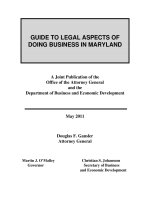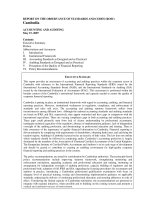THE COLLAPSE OF VINASHIN AND CORPORATE GORVERNANCE PROBLEMS
Bạn đang xem bản rút gọn của tài liệu. Xem và tải ngay bản đầy đủ của tài liệu tại đây (105.03 KB, 7 trang )
THE COLLAPSE OF VINASHIN AND CORPORATE GORVERNANCE
PROBLEMS
I.
Introduction to Vinashin and its collapse
a. Introduction
Harmony with economic development of the country,Vinashin Kansai
was established in Hai Phong city,a center forthe steel industry in the
North.
With the aim to contribute part of their effort into modernization and
industrialization of the country,the production lines of modern steel
Kansai Vinashin buil twith a capacity of 300,000tons/year.
The main products are hot-rolled steel reinforced concrete with
dimensions from D10-D42 international standards and Vietnam which
have been registered at the General Department of Quality Measurement
and Quality Vietnam Kansai Vinashin work with only the"PrestigeQuality on each steel plant"
b. The collapse
When Vinashin, the now ailing Vietnamese state shipbuilder, raised about
$1bn from international investors in 2007, everyone felt like a winner.
The company got the cash it needed to expand, the government
demonstrated that Vietnam was integrating into the global economy, the
investors got some much needed yield and the bankers got their fees
(chiefly at Credit Suisse and Deutsche Bank). But, with the near-bankrupt
company now unable to pay its debts and creditors frustrated at the lack
of communication, Vinashin has become a case study in the perils of
emerging market debt investment.
After failing in December to make a $60m repayment on a $600m loan
arranged by Credit Suisse, Vinashin wrote to investors in a
1,000bn Vietnam dong ($48m) bond in January to tell them it was unable
to make the latest coupon payment.
Coupon payments are due on other bond tranches over the next few
months, including a 3,000bn Vietnam dong bond arranged by Deutsche
Bank in 2007.
Vinashin, which nearly collapsed after amassing debts of more than $4bn
while expanding into non-core activities, has appointed KPMG to advise
on its restructuring and told Bloomberg it will report back to creditors by
May or June.
But large banks like Credit Suisse and Standard Chartered, who are
among the creditors of the $600m Vinashin loan, have long term business
interests in Vietnam and are not quite so keen to clash with the
government.
II.
What are Corporate Governance problems in this case?
From documents of OECD (2004, page 17-25), corporate governance
included 06 basic rules:
“1. Hoạt động minh bạch theo thị trường trong khuôn khổ của luật pháp,
tuân thủ trách nhiệm và nghĩa vụ qui định của Nhà nước.
2. Bảo vệ và hỗ trợ quyền lợi của cổ đông/người lao động.
3. Đối xử bình đẳng đối với tất cả cổ đông, kể cả nhóm cổ đông thiểu số và
nước ngoài.
4. Nhận thức quyền hạn của cổ đông do luật pháp xác nhận hoặc thông qua
thỏa thuận giữa các bên, khuyến khích hợp tác năng động giữa các công ty
và các cổ đông.
5. Đảm bảo thông báo chính xác tình hình các hoạt động liên quan của công
ty, bao gồm tình tình tài chính, kết quả hoạt động, sở hữu và quản trị doanh
nghiệp.
6. Duy trì định hướng chiến lược của công ty, tính hiệu quả trong điều hành
của Ban Giám đốc công ty và trách nhiệm của HĐQT đối với công ty và cổ
đông.”
After the collapse of Vinashin, we see that the compliance with these above
governance rules was not concerned about properly. The violations are
mostly from inside main managers, it affected directly to company’s
performance about investment plans, using capital or managerial ability.
Source: />
Actually, the leader of this corporation was assigned too much powers (Mr.
Pham Thanh Binh was the Party Secretary and also CEO of Vinashin). A
person who held so much powers will create an autocratic institution and
uncontrollable investment. A typical example is that bought Hoa Sen ship
with 1,300 billion VND to do nothing.
Moreover, about poor managerial ability, shipbuilding is a major sector of
Vinashin, but focusing too much on making new ships; they ignored other
things such as repairing or improving the quality of ships. Therefore, they
created the poor-quality new ship and could not be sold. However,
investment in no-experience sectors (electricity, steel, finance ...) leading to
low-efficient projects and could not finish because of lack of funds,
therefore, causing delays, wastes and huge losses.
In addition, many managers had signs of embezzlement, corruption, selfinterest and concealing information but they were not detected and handled
immediately. The result of inspection has shown that investing in these
projects is to take advantages for personal purposes from corporation‘s
assets. The competence of Vinashin was not limited to, financial investments
of the State for them had no barriers while the state monitored and checked
loosely. CEO, BOD members, directors of Subsidiaries felt very easy to
mobilize and use the corporate capital and violate state law.
Besides, Central Inspection Commission (dated 05/7/2010) confirmed: "in
recent years, Vinashin has reported dishonestly about the financial
situation".
III.
Agency problems
Vinashin was a State-owned enterprise. It’s corporate governance remained
many problems and Vinashin had multiagency problems. That was the main
reason caused the company to collapse.
Vinashin Corporate mechanism.
Auditors
Investment banker
Analysts
Investment analysts
Credit agencies
Society
Creditors
Stock exchange
Government
Government
Internal audit
BOD
CEO
Managers
Employees
Market force
Vinashin had a complicated corporate governance mechanism.
It’s governing bodies is a Combination of the Party Committee
and the Board of Directors.
Vinashin’s objective is A Combination of National Goals and Company
Performance, not only profit.
There were agency problems in many points of Vinashin’s corporation
mechanisim:
Conflict between the government and the BOD.
The government assigned the board of directors on behalf as investors, while
professional managers are hired to manage Vinashin. The government is
principal of the BOD but they manage and monitor the agents weakly with
lack of restrictions and attention. This reality caused the BOD take
advantages of their power to attain their own interests through
embezzlement, corruption,…In detail, they had established many
subsidiaries whose operations were beyond the group’s core business, and
they were too slow to build a company charter and to introduce financial and
infrastructure investment management regulations and technical and
economic standards. The management of state-owned Vinashin group had
been ineffective. All their actions with lack of responsibility and
consideration about the national interest. For example, it was so wrong when
gave too much power and authority to the group chairman Pham Thanh
Binh. (Mr. Pham Thanh Binh was the Party Secretary and also CEO of
Vinashin). He could use his power to do for his own interest, neglected in
making investment decisions without an approved investment plan. He did
assign many of his relatives to the management systems of the company,
especially the case of his son.
The head of Vinashin from BOD to CEO and lower level of managers had
limited capacity, irresponsible, arbitrary, dishonest in reporting, violating the
law in compliance with the provisions of the State, the Prime Minister. They
shook hands and were just greedy for their own interests.
Conflict between management and the emloyees.
Vinashin did not pay wages and salaries to employee led to many of them
quitted their work at Vinashin.
Conflict between the company and the creditors.
Vinashin financing mostly were debts from issuing bonds both domestically
and internationally. Vinashin failed to meet extended deadline to make loan
payment to foreign creditors led to many conflict and legal issue.
Vinashin reported the wrong number to the creditors and society to hide their
poor performance.
Conflict between Vinashin to the society.
Vinashin was a cheating enterprise to the society about it’s financial reports
of cooking numbers, using public money to do business unconstructively and
foolishly led to significant waste of national capital.
In general, Vinashin had a very bad corporate governance.
The government steps in
On August 12, 2010 the Prime Minister established a steering committee to
restructure Vinashin. Permanent Deputy Prime Minister Nguyen Sinh Hung
will be in charge of the committee while another Deputy Prime Minister,
Hoang Trung Hai, was named as vice chair, demonstrating the seriousness of
the situation. The 14 other members are representatives from relevant
ministries, branches and sectors.
The committee’s task is to study the situation and propose policies and other
remedies for Vinashin, as well as to organise the implementation of these
policies and measures to enable it to stabilise and develop its business. The
committee also gives instructions to the mass media in disseminating
information on Vinashin’s situation and the government’s plans.
The committee is composed of two working groups and a coordinating
section. Working Group No. 1 is in charge of organisational restructuring,
development strategy, and the direction of investment, production and
business lines for Vinashin. Working Group No. 2 is responsible for
reshaping Vinashin’s financial structure to ensure that it is able to cover
debts, production, business and investment activities.
The government’s policy is to restructure Vinashin with the objective of
reducing its debt, restoring capital and cutting losses to a minimum. In
particular, the government aims to prevent the Vinashin case from negatively
affecting macro-economic stability and the investment environment in
Vietnam. The state will ensure sufficient capital to Vinashin to pay off
mature foreign debts. Vinashin’s mission will be to restructure production
loans and debts to suppliers while completing projects.
IV.
Summary
The case of Vinashin was a typical example of managing loosely of
Government to State-owned enterprise. By giving too much power and
authority to the chairman, Government has indirectly destroyed Vinashin. As
a result, Vinashin has caused serious consequences affecting the country's
economy. Although Government has to take measures to save the situation
and restructure one of the biggest state-owned corporations, this is still a
memorable lesson in administrating state-owned enterprise.









